
The Palazzo Massari, also known as the Palazzo Rosso, is a Renaissance-style palace located on Borso and Corso Porta Mare, at the northwest corner of Piazza Ariostea, in Ferrara, region of Emilia-Romagna, Italy.

The Palazzo Massari, also known as the Palazzo Rosso, is a Renaissance-style palace located on Borso and Corso Porta Mare, at the northwest corner of Piazza Ariostea, in Ferrara, region of Emilia-Romagna, Italy.
Built in late 1591, commissioned by Count Onofrio Bevilacqua from Alberto Schiatti, the palace has a two-story, sober classical facade with twin windows separated by pilasters, Ionic on ground floor and Corinthian on the second floor. In the 1780s, the smaller Palazzina Bianca (in contrast to the larger "pink palazzo"), also known as the Palazzina dei Cavalieri di Malta, was built adjacent to the other palace. In addition, a Neoclassical pavilion designed by Luigi Cosimo Bertelli, called the Coffee House, was added.
In the 19th century, the palace became property of the Massari family, who then sold it to the Comune of Ferrara. Since 1975, it has housed the Museum of Modern and Contemporary Art of the city. It now also houses the collections of three other museums: Museo Giovanni Boldini, Museo dell'Ottocento, and Museo d'Arte Moderna e Contemporanea "Filippo de Pisis". [1] [2]
The gardens belonging to the palace were landscaped by Luigi Cosimo Bertelli in the 18th century as formal Italian gardens; in the 19th century Count Massari turned them into a less formal English garden. Since the 1970s, the gardens adjacent to the Palazzo Massari host outdoor modern sculptures. Among the works and artists displayed are: [3]

Ca' Rezzonico is a palazzo on the Grand Canal in the Dorsoduro sestiere of Venice, Italy. It is a particularly notable example of the 18th century Venetian baroque and rococo architecture and interior decoration, and displays paintings by the leading Venetian painters of the period, including Francesco Guardi and Giambattista Tiepolo. It is a public museum dedicated to 18th-century Venice and one of the 11 venues managed by the Fondazione Musei Civici di Venezia.

The Palazzo Pitti, in English sometimes called the Pitti Palace, is a vast, mainly Renaissance, palace in Florence, Italy. It is situated on the south side of the River Arno, a short distance from the Ponte Vecchio. The core of the present palazzo dates from 1458 and was originally the town residence of Luca Pitti, an ambitious Florentine banker.

The Palazzo Medici, also called the Palazzo Medici Riccardi after the later family that acquired and expanded it, is a Renaissance palace located in Florence, Italy. It is the seat of the Metropolitan City of Florence and a museum.

The Palazzina di caccia of Stupinigi is one of the Residences of the Royal House of Savoy in northern Italy, part of the UNESCO World Heritage Sites list. Built as a royal hunting lodge in the early 18th century, it is located in Stupinigi, a suburb of the town of Nichelino, 10 km (6 mi) southwest of Turin

Palazzo Schifanoia is a Renaissance palace in Ferrara, Emilia-Romagna (Italy) built for the Este family. The name "Schifanoia" is thought to originate from "schivar la noia" meaning literally to "escape from boredom" which describes accurately the original intention of the palazzo and the other villas in close proximity where the Este court relaxed. The highlights of its decorations are the allegorical frescoes with details in tempera by or after Francesco del Cossa and Cosmè Tura, executed ca 1469–70, a unique survival of their time.

Palazzo Grassi is a building in the Venetian Classical style located on the Grand Canal of Venice (Italy), between the Palazzo Moro Lin and the campo San Samuele.

Palazzo Braschi[paˈlat.tso ˈbras.ki] is a large Neoclassical palace in Rome, Italy and is located between the Piazza Navona, the Campo de' Fiori, the Corso Vittorio Emanuele II and the Piazza di Pasquino. It presently houses the Museo di Roma, the "museum of Rome", covering the history of the city in the period from the Middle Ages through the nineteenth century.

Palazzo dei Diamanti is a Renaissance palace located on Corso Ercole I d'Este 21 in Ferrara, region of Emilia Romagna, Italy. The main floor of the Palace houses the Pinacoteca Nazionale di Ferrara.

The Royal Palace of Turin is a historic palace of the House of Savoy in the city of Turin in Northern Italy. It was originally built in the 16th century and was later modernized by Christine Marie of France (1606–1663) in the 17th century, with designs by the Baroque architect Filippo Juvarra. The palace also includes the Palazzo Chiablese and the Chapel of the Holy Shroud, the latter of which was built to house the famous Shroud of Turin. In 1946, the building became the property of the state and was turned into a museum. In 1997, it was placed on the UNESCO World Heritage Site list along with 13 other residences of the House of Savoy.

San Marco is a religious complex in Florence, Italy. It comprises a church and a convent. The convent, which is now the Museo Nazionale di San Marco, has three claims to fame. During the 15th century it was home to two famous Dominicans, the painter Fra Angelico and the preacher Girolamo Savonarola. Also housed at the convent is a famous collection of manuscripts in a library built by Michelozzo.

The Palazzo Buonaccorsi is an 18th-century aristocratic palace, now the civic museum of the town, located on Via Don Minzoni 24 in the historic center of Macerata, region of Marche, Italy.

Anton Domenico Gabbiani was an Italian painter and active in a late Baroque style.

Cosimo Morelli was an Italian architect, active throughout the Papal States in a Neoclassic style.

The Galleria Estense is an art gallery in the heart of Modena, centred around the collection of the d’Este family: rulers of Modena, Ferrara and Reggio from 1289 to 1796. Located on the top floor of the Palazzo dei Musei, on the St. Augustine square, the museum showcases a vast array of works ranging from fresco and oil painting to marble, polychrome and terracotta sculpture; musical instruments; numismatics; curios and decorative antiques.
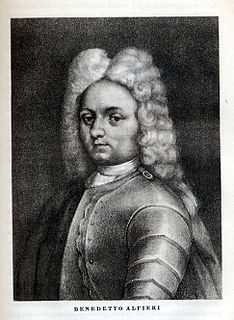
Benedetto Innocenzo Alfieri was an Italian architect, a representative of the late-Baroque or Rococo style.
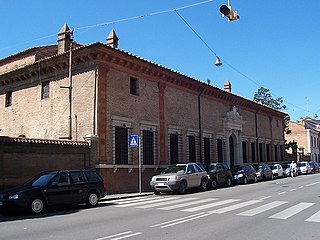
The Palazzina Marfisa d’Este is a Renaissance-style small palace, once suburban, and sometimes referred to as a villa, located on Corso Giovecca #170, just east of Central Ferrara, region of Emilia-Romagna, Italy.
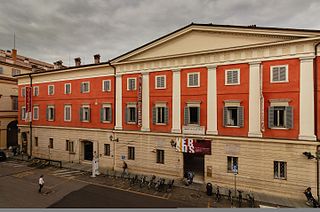
The Palazzo Santa Margherita is a Neoclassical-style palace located on Corso Canalgrande #103 in the central Modena region of Emilia-Romagna in Italy.
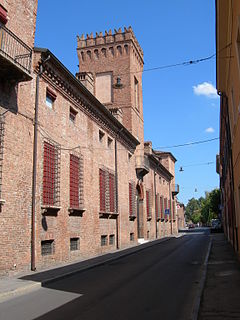
The Palazzo Bonacossi is a Renaissance architecture palace located on Via Cisterna del Follo #5 in Ferrara, Italy. The 15th-century palace is the home of the Musei Civici di Arte Antica e Museo Riminaldi.
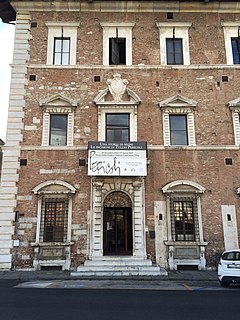
The Palazzo Lanfranchi is a palace located on Lungarno Galileo Galilei #8, in the city of Pisa, region of Tuscany, Italy.

The Palazzo degli Anziani also known as the Palazzo del Comune, della Comunitá or del Giano is a Gothic-style stone palace located in the ancient historic center of Pistoia, Tuscany, Italy. The palace served as city hall for centuries; it still belongs to the comune and now mainly houses the Museo Civico d'Arte Antica.